The great white shark stands as one of the ocean’s most captivating and formidable creatures, evoking both fascination and fear among those who encounter it. They are known for their massive size, powerful jaws, and razor-sharp teeth. One of the most common questions people have about these sharks is how many teeth they have. As a language model, I can tell you that great white sharks have a lot of teeth. In fact, they have multiple rows of teeth that are constantly being replaced throughout their lives.
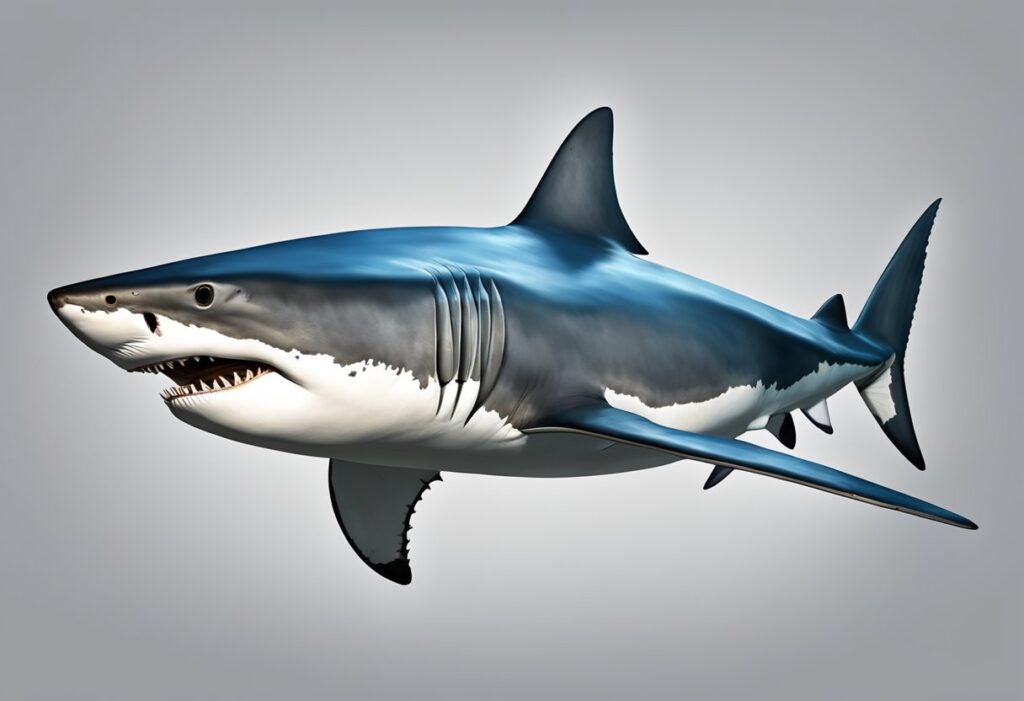
The anatomy of great white shark teeth is fascinating. These teeth are triangular in shape and have serrated edges that can easily slice through flesh. The teeth are also curved, which helps the shark to grip and hold onto its prey. Unlike humans, great white sharks do not use their teeth for chewing. Instead, they use their teeth to grab onto their prey and tear off chunks of flesh.
Key Takeaways
- Great white sharks have multiple rows of triangular, serrated teeth that are constantly being replaced throughout their lives.
- The teeth are curved, which helps the shark to grip and hold onto its prey.
- Great white sharks do not use their teeth for chewing, but rather for grabbing onto their prey and tearing off chunks of flesh.
Anatomy of Great White Shark Teeth

As a marine biologist, I have studied the anatomy of several shark species, including the great white shark. Great white sharks are known for their sharp teeth that can grow up to 3 inches long. In this section, I will discuss the anatomy of great white shark teeth, including their types, structure, replacement, and growth.
Types of Teeth
Great white sharks have several types of teeth, including upper and lower teeth, and anterior and posterior teeth. The upper teeth are larger and broader than the lower teeth, and they are triangular in shape. The anterior teeth are serrated, while the posterior teeth are smooth-edged. The serrated teeth are used for cutting and tearing prey, while the smooth-edged teeth are used for crushing and grinding.
Great white sharks boast a diverse dental repertoire: serrated blades for cutting, smooth-edged molars for crushing. Each tooth, a specialized tool in the relentless pursuit of prey.
Tooth Structure
The structure of great white shark teeth is similar to that of other shark species. The teeth are composed of dentin, a hard, dense, and calcified tissue that forms the bulk of the tooth. The outer layer of the tooth is covered by enamel, a hard and mineralized material that protects the tooth from wear and tear. The root of the tooth is embedded in the jawbone, and it is surrounded by a layer of cementum, a thin layer of connective tissue that helps anchor the tooth in place.
Like the great white’s teeth, strength lies in the unseen structure beneath the surface. Enamel shields, but it’s the dense core of dentin that endures the bite of time.
Tooth Replacement and Growth
Great white sharks have multiple rows of teeth that are constantly replaced throughout their lives. The teeth are arranged in a conveyor belt-like system, where the front row of teeth is used for hunting, while the back rows of teeth are in various stages of development. When a tooth is lost or damaged, a new tooth grows in its place. The rate of tooth replacement varies depending on the age and size of the shark, but it can be as frequent as every 10 days.
In conclusion, great white shark teeth are fascinating structures that are essential for their survival. Understanding the anatomy of great white shark teeth can provide valuable insights into their behavior, ecology, and evolution.
Great white sharks, masters of adaptation, boast a dental conveyor belt: teeth in constant renewal for unyielding predation. Their ever-evolving arsenal unveils the essence of survival in the depths.
Anatomy of Great White Shark Teeth

As a marine animal, the Great White Shark has unique teeth that are perfectly suited for its predatory lifestyle. In this section, I will provide an overview of the anatomy of Great White Shark teeth, including their types, structure, and replacement and growth.
Types of Teeth
Great White Sharks have several types of teeth that are specifically adapted to their hunting and feeding behaviors. Their teeth are triangular and serrated, and they are arranged in rows that can be replaced throughout their life. The teeth at the front of the mouth are pointed and sharp, designed to grab and hold prey, while the teeth at the back of the mouth are flatter and wider, designed to crush and grind prey.
Tooth Structure
The structure of Great White Shark teeth is unique and highly specialized. The teeth are made of a hard, enamel-like substance called dentin, which is covered by a layer of enamel. The enamel is the hardest substance in the body and is designed to withstand the wear and tear of biting and chewing. The dentin is softer and more flexible, allowing the teeth to absorb the shock of biting down on prey.
Tooth Replacement and Growth
Great White Sharks have a remarkable ability to replace and grow their teeth throughout their lifetime. They have multiple rows of teeth that can be replaced as needed, with new teeth growing in behind the old ones. When a tooth is lost or damaged, a new tooth will move forward to take its place. This process ensures that the shark always has a full set of sharp, functional teeth.
In conclusion, the anatomy of Great White Shark teeth is highly specialized and perfectly adapted to their predatory lifestyle. Their teeth are triangular and serrated, with a hard enamel-like substance called dentin covered by a layer of enamel. They have multiple rows of teeth that can be replaced throughout their lifetime, ensuring that they always have a full set of sharp, functional teeth.
Anatomy of Great White Shark Teeth

As a marine biologist, I have had the opportunity to study the anatomy of various shark species, including the great white shark. The great white shark is known for its sharp, serrated teeth, which are used for hunting prey. In this section, I will discuss the anatomy of great white shark teeth, including the types of teeth, tooth structure, and tooth replacement and growth.
Types of Teeth
Great white sharks have several types of teeth, each with a different function. The front teeth, or anterior teeth, are triangular and pointed, and are used for grabbing and holding onto prey. The teeth towards the back, or posterior teeth, are broader and flatter, and are used for cutting and tearing flesh. These teeth are also serrated, which helps the shark to grip onto its prey and tear off chunks of flesh.
Tooth Structure
The structure of great white shark teeth is similar to that of other shark species. The teeth are made of dentin, a hard, dense material that makes up most of the tooth. The outer layer of the tooth, called the enamel, is the hardest substance in the body and protects the tooth from damage. The root of the tooth is embedded in the jaw, and the tooth is held in place by a fibrous membrane called the periodontal ligament.
Tooth Replacement and Growth
Great white sharks have multiple rows of teeth, with each row containing around 50 teeth. As the front teeth become worn or damaged, they are replaced by teeth from the row behind. The replacement teeth are constantly growing and pushing forward, and can replace a lost tooth within a day or two. This process of tooth replacement and growth ensures that the shark always has a fresh set of teeth for hunting and feeding.
In conclusion, the anatomy of great white shark teeth is fascinating and unique. These teeth are perfectly adapted for hunting and feeding, with different types of teeth serving different functions. The structure of the teeth is strong and durable, and the process of tooth replacement and growth ensures that the shark always has a sharp set of teeth.
Anatomy of Great White Shark Teeth
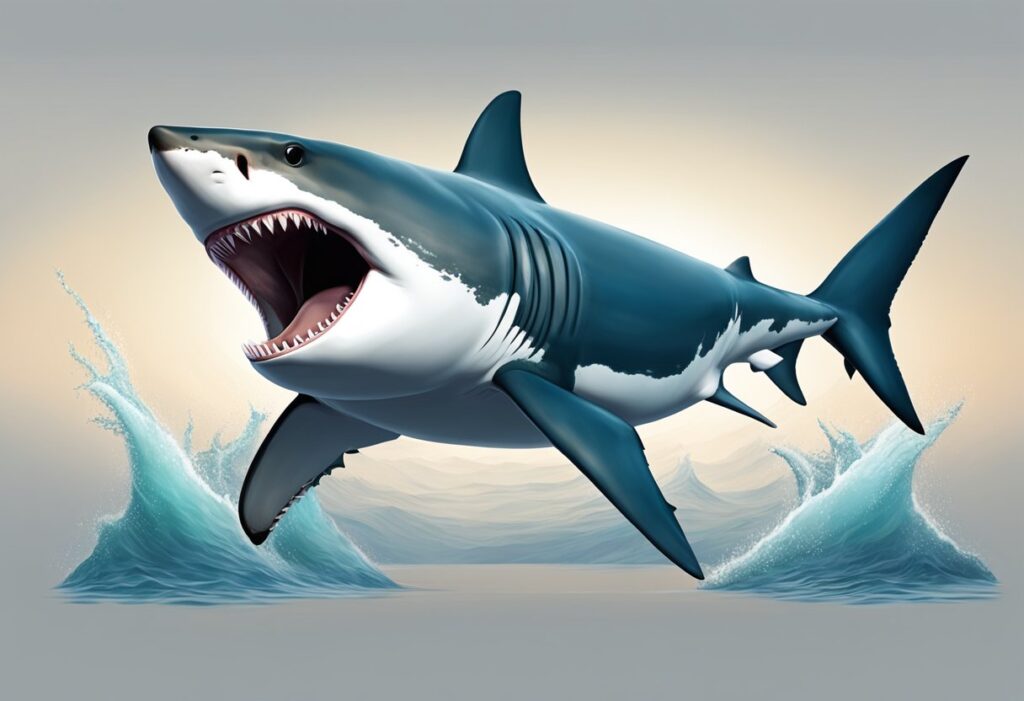
As a marine biologist, I have studied the anatomy of the Great White Shark extensively, including its teeth. Great White Sharks are known for their large, sharp teeth that are perfectly adapted for hunting and feeding.
Types of Teeth
Great White Sharks have several types of teeth in their mouths, including:
- Anterior Teeth: These teeth are located at the front of the jaw and are used for grabbing and holding onto prey.
- Lateral Teeth: These teeth are located in the middle of the jaw and are used for cutting and slicing prey.
- Posterior Teeth: These teeth are located at the back of the jaw and are used for crushing and grinding prey.
The teeth of the Great White Shark are serrated and triangular in shape, with a pointed tip that is designed to penetrate flesh easily. These teeth are also constantly replaced throughout the shark’s lifetime.
Tooth Structure
The teeth of the Great White Shark are composed of several layers of tissue, including:
- Enamel: This is the hard, outer layer of the tooth that protects it from damage.
- Dentin: This is the softer layer of tissue beneath the enamel that gives the tooth its shape and structure.
- Pulp: This is the innermost layer of tissue that contains nerves and blood vessels.
The teeth of the Great White Shark are also hollow, which allows them to detect vibrations in the water and locate prey.
Tooth Replacement and Growth
Great White Sharks have a unique tooth replacement and growth system that allows them to constantly replace their teeth throughout their lifetime. When a tooth is lost or damaged, a new tooth will grow in to take its place.
Great White Sharks can have up to 300 teeth in their mouths at any given time, with multiple rows of teeth that are ready to replace any lost or damaged teeth. As a result, Great White Sharks are able to maintain their sharp, effective teeth throughout their lives.
In conclusion, the teeth of the Great White Shark are a fascinating and important aspect of their anatomy. Their teeth are perfectly adapted for hunting and feeding, and their unique tooth replacement and growth system allows them to maintain their sharp teeth throughout their lives.
Anatomy of Great White Shark Teeth

As a marine biologist, I have studied the teeth of various shark species, including the Great White Shark. In this section, I will discuss the anatomy of Great White Shark teeth, including their types, structure, and growth.
Types of Teeth
Great White Sharks have several types of teeth, each with a specific function. They have triangular-shaped teeth in the upper jaw that are designed for grabbing and tearing prey. The lower jaw has more slender and needle-like teeth that are used for gripping and cutting. The teeth are arranged in several rows, and as the front teeth are lost, the ones behind move forward to replace them.
Tooth Structure
Great White Shark teeth are composed of dentin and enamel, similar to human teeth. However, the enamel of shark teeth is much thicker and harder, making them more durable and resistant to damage. The dentin, which is the softer layer beneath the enamel, is responsible for the tooth’s shape and structure.
Tooth Replacement and Growth
Great White Sharks have a unique ability to replace their teeth continuously throughout their lifetime. When a tooth is lost, a new one grows in its place, typically within a few days. The new tooth is usually larger and sharper than the one it replaces.
In conclusion, Great White Shark teeth are a marvel of nature, designed for efficient hunting and feeding. Their unique structure and ability to replace teeth continuously make them one of the most fascinating aspects of shark anatomy.
Dental Count
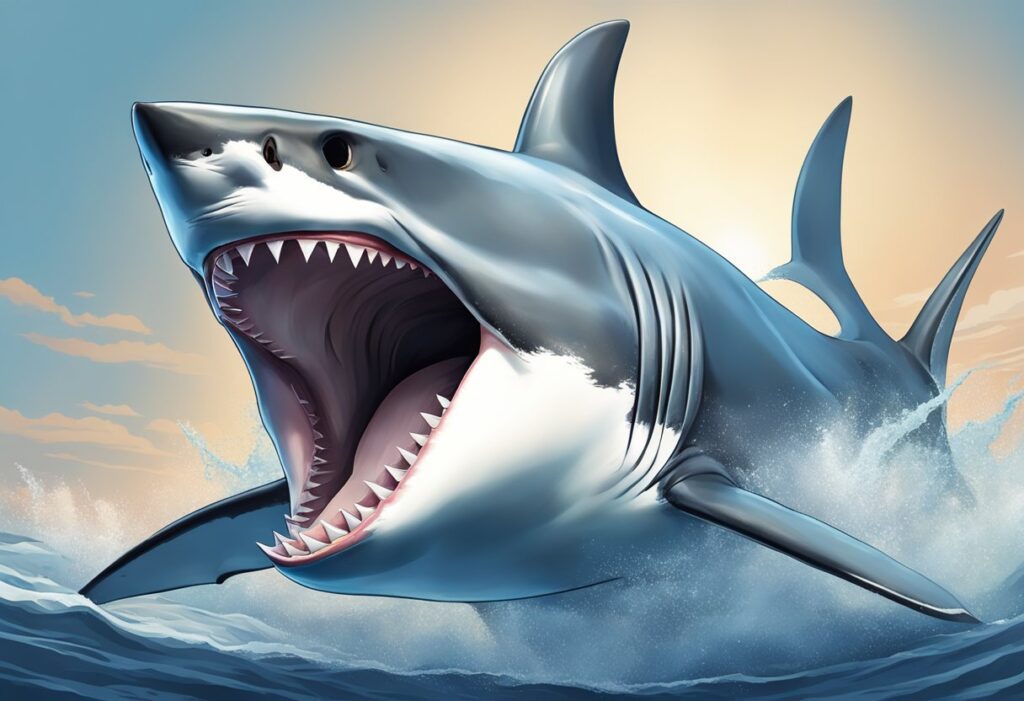
As a marine biologist, I have always been fascinated by the great white shark’s teeth. These apex predators are known for their impressive dental count and razor-sharp teeth. In this section, I will discuss the average number of teeth in a great white shark’s mouth and the variability in tooth count.
Average Number of Teeth
On average, a great white shark has around 50 to 60 teeth in its mouth at any given time. However, this number can vary depending on the shark’s age, size, and feeding habits. Great white sharks have multiple rows of teeth that are constantly being replaced throughout their lifetime. As a tooth is lost or broken, another tooth from the row behind it moves forward to take its place.
Variability in Tooth Count
While the average number of teeth in a great white shark’s mouth is around 50 to 60, some sharks have been known to have up to 300 teeth at a time. This variability in tooth count can be attributed to a variety of factors, including the shark’s size, age, and feeding habits. Larger sharks tend to have more teeth than smaller sharks, and older sharks may have more worn-down teeth than younger ones.
Great white shark teeth are unique in their shape and size. These teeth are triangular in shape and can grow up to 3 inches in length. They have serrated edges that are perfect for tearing through flesh and bone. Great white shark teeth are also known for their durability and strength, which allows them to withstand the immense pressure of biting through tough prey.
In conclusion, the dental count of a great white shark is an impressive sight to behold. With an average of 50 to 60 teeth in its mouth at any given time, these apex predators are well-equipped for their role as top predators in the ocean. The variability in tooth count can be attributed to a variety of factors, including the shark’s size, age, and feeding habits.
“Great white sharks, with their formidable jaws, showcase variability in tooth count, ranging from 50 to a staggering 300. Influenced by size, age, and diet, each tooth, triangular and serrated, epitomizes the apex predator’s mastery of the ocean’s domain.”
Function of Teeth in Predation
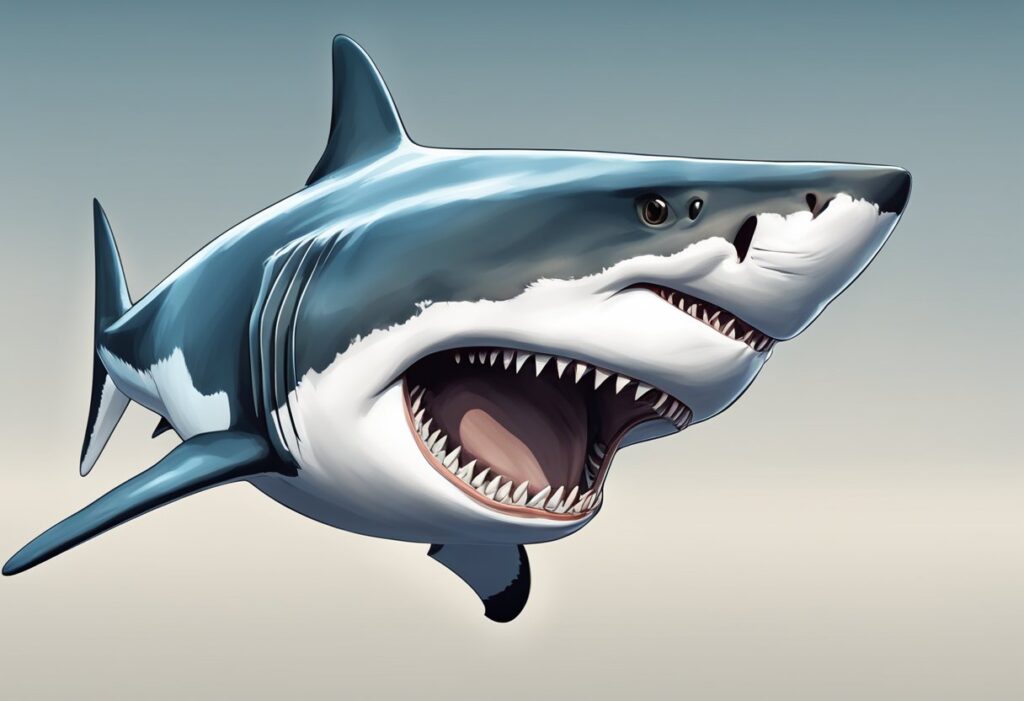
Hunting Technique
As a top predator in the ocean, the Great White Shark’s hunting technique involves a combination of stealth, speed, and power. When hunting, the shark will typically swim close to the surface and use its keen sense of smell to detect prey. Once a potential target is identified, the shark will use its powerful tail to propel itself towards the prey at high speed.
The Great White Shark’s teeth play a crucial role in its hunting technique. The shark has rows of teeth that are constantly replaced throughout its lifetime. Each tooth is shaped like a triangular blade with serrated edges, which allows the shark to grip and tear its prey with ease. The teeth are also arranged in a specific pattern that helps the shark to efficiently capture and consume its prey.
Role in Diet
The Great White Shark’s diet consists mainly of fish, seals, and other marine mammals. The shark’s teeth are perfectly suited to its diet, as they are designed to grip and tear through the tough skin and flesh of its prey.
The shark’s teeth are also used to crush the shells of crustaceans and other hard-shelled prey. The Great White Shark’s teeth are incredibly strong and can exert a bite force of up to 18,000 Newtons, making them one of the most powerful jaws in the animal kingdom [1].
In conclusion, the Great White Shark’s teeth play a crucial role in its hunting technique and diet. The shark’s teeth are perfectly adapted to its environment and allow it to efficiently capture and consume its prey.
[1] Source: Three‐dimensional computer analysis of white shark jaw mechanics
Evolutionary Perspective

Historical Development
As a species, the great white shark has been around for millions of years, and during that time, their teeth have evolved and adapted to suit their hunting needs. Great white shark teeth are unique, with serrated edges that allow them to grip and tear through their prey’s flesh.
Fossil records show that the great white shark’s teeth have changed over time. The earliest known ancestor of the great white shark, the Carcharodon hastalis, had teeth that were much smaller and thinner than the modern great white shark’s teeth. Over time, the teeth grew larger and more robust, allowing the great white shark to hunt larger prey.
Comparative Analysis With Other Sharks
When compared to other sharks, the great white shark has a unique set of teeth. While most sharks have multiple rows of teeth that they can replace as needed, the great white shark has only one row of teeth that are constantly being replaced throughout their lifetime.
Additionally, great white shark teeth are larger and more triangular than those of other sharks, which helps them to grip and tear through their prey’s flesh. For example, the teeth of the mako shark are thinner and more pointed, whereas the teeth of the tiger shark are broader and more serrated.
In conclusion, the great white shark’s teeth have evolved over millions of years to suit their hunting needs. They have only one row of teeth that are constantly being replaced throughout their lifetime, and their teeth are larger and more triangular than those of other sharks.
The great white shark’s teeth are unique among its peers. With a single row constantly replaced, these large, triangular teeth are expertly designed for gripping and tearing prey. Unlike other sharks, the great white’s dental arsenal reflects millions of years of evolutionary refinement, securing its status as the ocean’s ultimate predator.
Conservation and Research
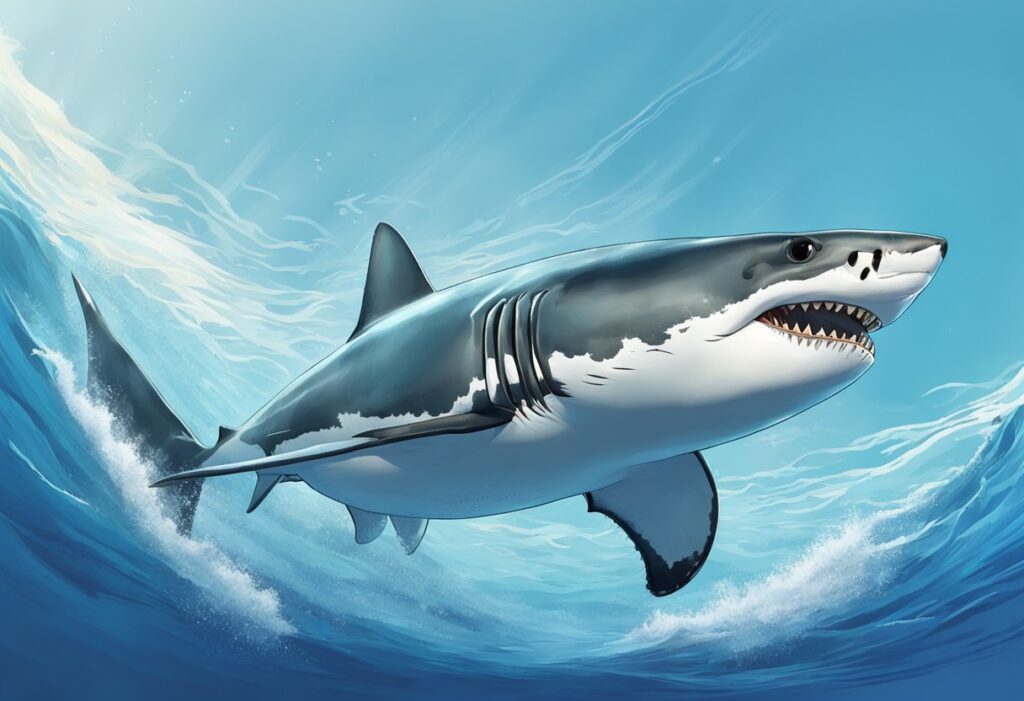
Importance of Dental Studies
As a marine apex predator, the great white shark plays an important ecological role in maintaining the balance of the ocean’s food chain. However, the species is also facing threats from overfishing, habitat loss, and human persecution. To protect the great white shark, we need to understand its behavior, biology, and ecology, which is where dental studies come in.
Great white shark teeth are unique in their shape, size, and function. They are triangular, serrated, and can grow up to 3 inches long. By examining the teeth, researchers can determine the age, sex, diet, and migration patterns of individual sharks. This information is crucial for developing effective conservation strategies and managing the species’ populations.
Impact on Shark Conservation
The study of great white shark teeth has led to several important discoveries that have helped to advance shark conservation efforts. For example, researchers have found that the great white shark has a low genetic diversity, which makes the species vulnerable to environmental changes and human impacts. This information has led to the development of conservation programs that aim to protect the species’ genetic diversity and prevent its extinction.
Additionally, dental studies have shown that the great white shark feeds on a variety of prey, including fish, seals, and whales. By understanding the species’ diet, researchers can identify the key prey species that need protection and develop measures to reduce the impact of human activities on these species.
In conclusion, dental studies play a critical role in understanding the biology and ecology of the great white shark. By examining the teeth, researchers can gather valuable information that can inform conservation efforts and help protect this iconic species.
Frequently Asked Questions
How many rows of teeth are typical in a great white shark?
Great white sharks have several rows of teeth that are positioned behind each other. The number of rows can vary, but typically great white sharks have about 5-6 rows of teeth.
What is the average number of teeth a great white shark has during its lifetime?
Great white sharks can have up to 50,000 teeth during their lifetime. However, they do not have all of these teeth at once. Instead, they constantly lose and replace their teeth throughout their lifetime.
How frequently do great white sharks lose and replace their teeth?
Great white sharks lose and replace their teeth constantly throughout their lifetime. They can lose up to one tooth per week, and their teeth can be replaced within a day or two.
